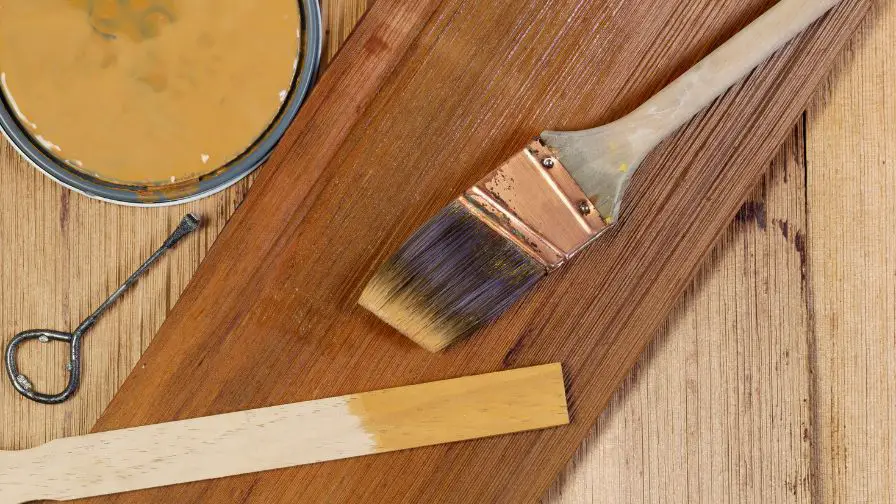
When it comes to staining wood, there are a lot of different options to choose from. You can use dye, stain, or paint – and each one has its own set of pros and cons. In this blog post, we will compare wood dye vs gel stain and help you decide which is the best option for your project!
Table of Contents
What Is Wood Dye And How Does It Work
Wood dye is a product that is used to color wood. It is available in a variety of colors and can be applied using a brush, sprayer, or dipping method. Wood dye penetrates the wood grain and deposits color within the cells of the wood.
The main advantage of using wood dye is that it provides uniform coloration. Wood dye can also be mixed to create custom colors. Another advantage of using wood dye is that it does not require a topcoat, which saves time and money.
What Are Pros Of Using Wood Dye
There are a few advantages to using wood dyes.
- Because wood dye is in a liquid form, it penetrates deeper into the wood grain than a gel stain. This is beneficial if you are trying to achieve a color that is significantly different from the natural color of the wood.
- You can find wood dyes in just about any color imaginable. This gives you a lot of flexibility when it comes to choosing the perfect color for your project.
- If you can’t find the exact color you’re looking for, you can always mix two or more colors together to create your own custom color.
- A little bit of wood dye goes a long way, so you don’t have to worry about using too much.
So there you have it! A few of the pros of using wood dye.
Subscribe to WoodworkersJournal
What Are The Cons Of Using Wood Dye
The main disadvantage of using wood dye is that it can be difficult to achieve consistent results. It is also important to note that wood dye will darken the wood grain over time.
If you are looking for a quick and easy way to add color to your woodworking projects, then wood dye may be the right option for you. However, if you are looking for a more durable finish, then gel stain may be a better option.
What Is Gel Stain And How Does It Work
Gel stain is a type of pigmented stain that comes in a gel form. Unlike traditional wood stains, which are absorbed into the wood, gel stains sit on top of the wood. Gel stains are ideal for staining vertical surfaces and for refinishing old furniture without stripping it first.
One of the biggest advantages of gel stain is that it’s very easy to apply. You simply wipe it on with a cloth or brush, and then wipe off any excess. This makes gel stain a great choice for beginners who are new to staining wood.
Another advantage of gel stain is that it doesn’t require any special equipment or skills to apply. All you need is a cloth or brush and some elbow grease.
One of the main disadvantages of gel stain is that it doesn’t penetrate the wood like traditional stains do. This means that it doesn’t provide as much protection from the elements, and it can be more susceptible to wear and tear.
What Are The Pros Of Using Gel Stain
Gel stain is a great option if you are looking for a durable finish.
- It can withstand heavy wear and tear and is ideal for high traffic areas.
- Gel stain is also easy to apply and can be applied in thin or thick coats depending on your desired look.
- Another plus is that gel stain does not require a primer, making it a time saver.
- Gel stain can also be applied to non-porous surfaces and will not raise the grain of the wood like some other types of stains.
Subscribe to Family Handyman
What Are The Cons Of Using Gel Stain
Just as with any product, there are a few drawbacks to using gel stain.
- One of the main disadvantages is that it can be difficult to achieve consistent results.
- Gel stain also tends to darken over time, so you may need to reapply it more often than you would with other types of stains.
- Lastly, gel stain can be more expensive than other types of stains.
Gel stain is a great option if you are looking for a durable and easy-to-apply finish. However, if you are looking for a stain that is easy to achieve a consistent color with, you may want to consider another option.
Which Is Better – Wood Dye Or Gel Stain
If you are unsure about which to use on your next woodworking project Wood dye is used to change the color of wood while gel stain is used to give wood a more natural look.
So if you are looking for a more drastic color change, wood dye is the way to go. If you are simply trying to enhance the natural look of the wood, gel stain would be a better option.
There are also some other key differences between wood dye and gel stain that you should take into account before making your decision.
Oil-based products will typically take longer to dry than water-based solutions. Wood dye will also penetrate the wood more deeply than gel stain.
This means that wood dye is more likely to change the color of the wood grain itself, while gel stain will mostly just sit on top of the wood.
So if you are trying to achieve a uniform color, wood dye is probably your best bet. But if you want to retain some of the natural variations in the wood grain, gel stain would be a better choice.




